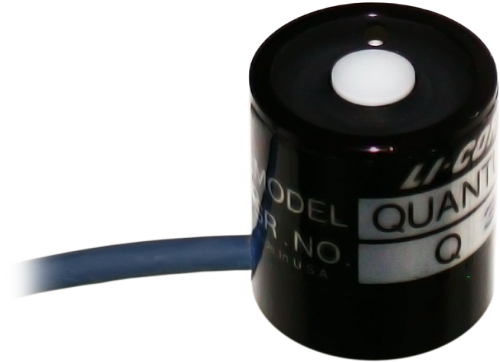This product is no longer available and has been replaced by: LI190R-L. Some accessories, replacement parts, or services may still be available.

| Services Available | |
|---|---|
| Repair | No |
| Calibration | Yes |
| Free Support | No |
Overview
The LI190SB, manufactured by LI-COR, is a quantum sensor that accurately monitors Photosynthetic Photon Flux Density (PPFD) in both natural and artificial light. It connects directly to our dataloggers and is ideal for growth chambers and greenhouses.
Read More
Benefits and Features
- Compatible with most Campbell Scientific data loggers
- Ideal for growth chambers and greenhouses
- Measures Photosynthetic Photon Flux Density (PPFD) in both natural and artificial light
- Compatible with the CWS900-series interfaces, allowing it to be used in a wireless sensor network
The "-L" on a product model indicates that the cable length is specified at the time of order.
Images

Detailed Description
The LI190SB measures solar radiation with a silicon photovoltaic detector mounted in a cosine-corrected head. A shunt resistor in the sensor’s cable converts the signal from microamps to millivolts, allowing the LI190SB to be measured directly by a Campbell Scientific datalogger.
LI190SB accurately measures Photosynthetic Photon Flux Density (PPFD), which is the number of photons in the 400 to 700 nm waveband incident per unit time on a unit surface. Because PPFD describes photosynthetic activity, the LI190SB is ideal for growth chambers and greenhouses.
Compatibility
Please note: The following shows notable compatibility information. It is not a comprehensive list of all compatible products.
Dataloggers
| Product | Compatible | Note |
|---|---|---|
| 21X (retired) | ||
| CR10 (retired) | ||
| CR1000 (retired) | ||
| CR10X (retired) | ||
| CR200X (retired) | ||
| CR211X (retired) | ||
| CR216X (retired) | ||
| CR23X (retired) | ||
| CR3000 (retired) | ||
| CR500 (retired) | ||
| CR5000 (retired) | ||
| CR510 (retired) | ||
| CR6 | ||
| CR800 (retired) | ||
| CR800 (retired) | ||
| CR850 (retired) | ||
| CR850 (retired) | ||
| CR9000 (retired) | ||
| CR9000X (retired) |
Additional Compatibility Information
Mounts
To ensure accurate measurements, the sensor should be leveled using an LI2003S leveling fixture, which incorporates a bubble level and three adjusting screws. The LI2003S leveling fixture mounts to a tripod or tower using the CM225 mount. The LI190SB should be mounted away from all obstructions and reflective surfaces that might adversely effect the measurement.
Data Logger Considerations
The LI190SB requires one differential analog input channel per probe.
Specifications
| Light Spectrum Waveband | 400 to 700 nm |
| Calibration | ±5% traceable to the U.S. National Institute of Standards Technology (NIST) |
| Sensitivity | Typically 5 μA per 1000 μmoles s-1 m-2 |
| Linearity | Maximum deviation of 1% up to 10,000 μmoles s-1 m-2 |
| Shunt Resistor | ±15% over thermal conductivity range (from 0.1 to 1.7 W m-2 K-1) |
| Stability | < ±2% change (over a 1 year period) |
| Response Time | 10 μs |
| Temperature Dependence | 0.15% per °C (maximum) |
| Cosine Correction | Cosine corrected up to 80° angle of incidence |
| Operating Temperature | -40° to +65°C |
| Relative Humidity | 0 to 100% |
| Detector | High stability silicon photovoltaic detector (blue enhanced) |
| Sensor Housing | Weatherproof anodized aluminum case (with acrylic diffuser and stainless-steel hardware) |
| Diameter | 2.38 cm (0.94 in.) |
| Height | 2.54 cm (1.00 in.) |
| Weight | 28 g (1 oz) |
Documents
Frequently Asked Questions
Number of FAQs related to LI190SB-L: 3
Expand AllCollapse All
-
This version is purchased directly from LI-COR and will not work directly with Campbell Scientific data loggers without modifications.
-
The LI190SB-L measures photosynthetically active radiation (PAR), a spectral range of solar radiation from 400 to 700 nm. This is the energy that plants use during photosynthesis. Measurements with the LI190SB-L are reported as photosynthetic photon flux density (PPFD).
The LI200X-L measures total solar radiation from 400 to 1100 nm. Measurements are usually reported in units of W/m2.
-
The information included on a calibration sheet differs with each sensor. For some sensors, the sheet contains coefficients necessary to program a data logger. For other sensors, the calibration sheet is a pass/fail report.
Privacy Policy Update
We've updated our privacy policy. Learn More